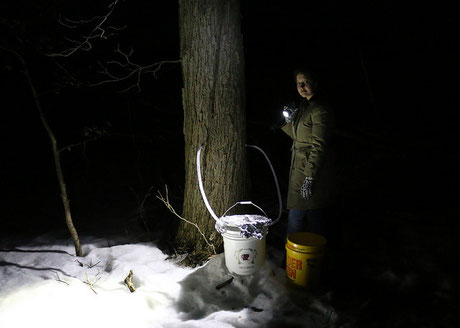Thursday 19th. Our folks sugared off 90 lbs. & Otis sugared off, but it has not been
weighed yet, for we could not bring it up it was so dark. I went there in the afternoon . . . & we did not get home till 25 minutes past 10. I took along something to eat, & we ate our
supper in the woods. We had to see by firelight as we had no candle. And that is the first supper we ate & the first evening we passed at our own home.
Friday 20th. . . . An Indian called & bought a pound of sugar. I went to Fathers
sugar-bush to see if Sol wanted me to help drain the sirup. He did not. . . . I went to Otis' bush toward night to help bring up the sugar that was left the night before. He boiled till eleven.
He got the big chair up in front of the fire, which is made of the end of an old stove-trough. There was one hole in the back, but he put a board on it & it makes a nice warm chair, &
there I sat & dozed as easily as a kitten.
_____
My own family began making maple syrup when we moved to Pennsylvania a decade ago, and I learned the history of the process through the Jennings Environmental Center in Slippery Rock. Since we can buy sugar at the store, we store our maple syrup instead of processing it further to a big loaf of sugar as Rosette's family did. But maple sugar, honey, and perhaps beet sugar were the only real sources of sweetener for the pioneers in Michigan, continued from the craft learned from the Indians in New York and New England in previous generations. Maple sugar was also very popular among the abolitionists, as a way of boycotting the slave-dependent cane sugar trade. (See "Sugaring Off," on the Greene, New York website, for more details)
"Sugaring-off," as Rosette calls it, is the process of collecting sap from maple trees--a good stand of trees being called a "sugar-bush"--and then boiling it down
over an open fire in wide, flat pans. It takes 40 gallons of sap to make one gallon of syrup, and that is then cooked down a bit further to crystallize into dry sugar. The Ramsdells and
Churchills made a good part of their living from this enterprise over several weeks each February-March--Rosette reports that she and Otis netted over 200 pounds of sugar their first season and
her parents 700 pounds (representing well over 3000 gallons of sap!). Later lower-quality sap was used to make vinegar, with the help of a "mother" or "starter" from another batch of
vinegar.
One of my favorite scenes in the journal is Rosette's account of the rest of the night recorded here--they stayed late to finish the sugaring-off (getting just the
right consistency) and then lost their way when they tried to go home! You'll have to read the novel to learn that story . . .
Use the link in the footer of this page to sign up for email updates and learn more
about maple sugar and candy.

The modern way of tapping maple trees is much the same as in Rosette's time. Betsy Marsch, artist for the cover of Rosette, collecting the sap from a day or two in March, 2015.





Write a comment
Will (Monday, 07 December 2015 05:08)
I was intrigued by the Abolition aspect of maple vs cane sugar and found this:
http://www.history.org/foundation/journal/autumn12/maplesugar.cfm
and this:
http://www.adirondackalmanack.com/2015/03/maple-syrup-production-and-slavery-2.html
Lots more hits out there. So, at our nation's founding, favoring maple sugar over cane sugar was a nationalist enterprise since cane sugar came from foreign colonies. Then, when the US acquired Spanish territories and expanded slavery there, opposition came from the abolitionists. Nowadays, Big Sugar is under attack from environmentalists. Poor cane sugar just can't catch a break.
Cindy Marsch (Monday, 07 December 2015 06:29)
Thanks for your historian's perspective, Will! I was amazed when I learned of the abolition angle (mentioned in the newsletter series for those on the email list), and it makes me wonder how ideological the Ramsdells were, and how much just good businesspeople. The first article's mention of 200 pounds being good production for a family made me proud of Mama and Papa Ramsdell's 700 pounds in 1857. :-)
Don't forget the healthy-eating folks who are against white sugar now, too! But I don't think maple sugar is much better on that score--I'm afraid the Ramsdell dental history is a painful one (at least two mentions of extractions in the journal).
Thanks for contributing!